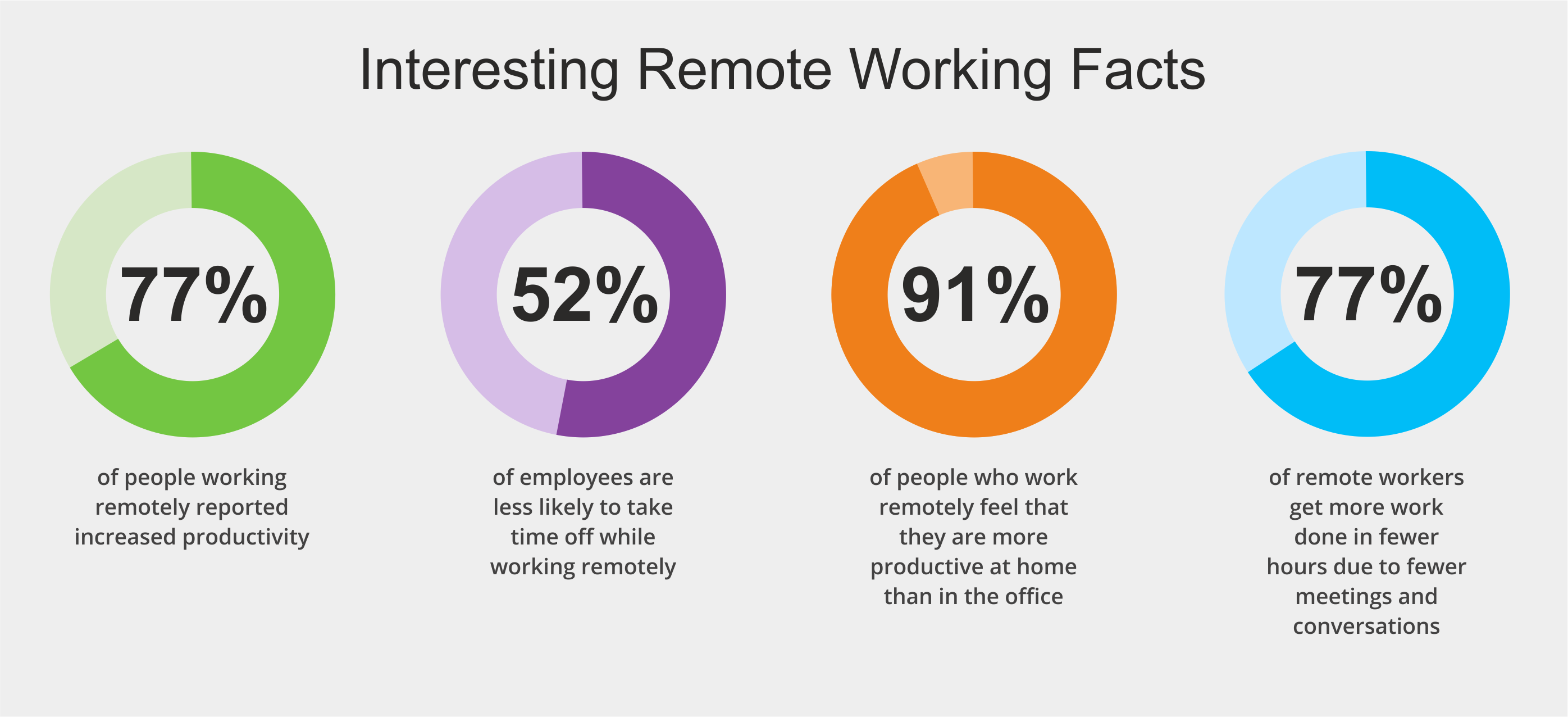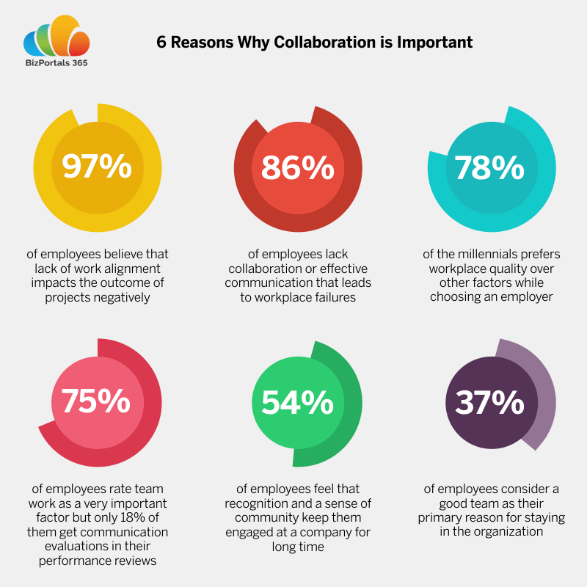Table of Contents
- Why is collaboration in the workplace important?
- The Role of a Centralized Collaboration Hub in Enabling Workplace Collaboration
- Exploring the Importance of Workplace Collaboration with the Power of a Modern Intranet
- Actionable Tips to Improve Workplace Collaboration
- How BizPortals 365 enhances collaboration in the workplace?
Step into a smarter digital workplace
Get a Free Product TourSummary
The importance of workplace collaboration can’t be overstated—it helps ideas grow, problems get solved faster, and teams stay connected. In this blog, you’ll discover how building a collaborative culture transforms the way your people work together. It also shows how a modern intranet supports these efforts by streamlining communication, centralizing resources, and enabling flexible, cross-functional teamwork.
Workplace collaboration refers to the process of different stakeholders working together within the organization. It involves sharing ideas, information, and responsibilities to help them achieve common goals more effectively.
With the rise of remote work, distributed teams, and virtual offices, the digital workplace has become the new normal. And the key to surviving and thriving in this new era is—a collaborative workplace.

As workplaces become more digital, it’s essential to understand how businesses can manage collaboration in this new era. So, what does collaboration really mean—and how can a digital workplace tool help make it easier and more effective? Let’s explore.
The development of modern technologies has not taken away the need for humans to interact with each other. We still need to collaborate effectively to complete a variety of tasks. Forget the days when the workplace referred to a physical office space occupied by the employees during regular working hours.
The new-age workplace is confined simply to a laptop screen. The work culture is more flexible. The employees like to be heard and wish to share knowledge across the organization. Business ideas are discussed and shared beyond the usual workgroups.
To match these changing needs of employee work experiences, they need a collaborative workplace where they can gain and share knowledge, communicate seamlessly, and bring productivity, efficiency, growth, and innovation.
Why is Collaboration in the Workplace Important?
Recent research shows that 81% of employers have already or are planning to redesign workspaces within 24 months, and 83% acknowledge that collaboration-driven enhancements effectively attract and retain top talent.
Clearly, collaboration is no longer just a buzzword—it’s a driving force behind organizational growth, innovation, and employee engagement.
It is because every individual has different skills, talents, and expertise. When all the team members collaborate, they can utilize their knowledge, skills, and experience to achieve the shared goal.
Collaboration also helps track project deliveries as employees combine their expertise to get things done in the workplace. It also allows employees to share their ideas while understanding how they think, work, and operate. This, in turn, can be mutually beneficial for employees and the organization.

However, it is equally important to understand the workplace collaboration challenges modern companies are facing.
To be honest, effective collaboration sounds great in theory, but in practice, it often comes with its own set of challenges. Simply having teams that work remotely or creating a digital channel to facilitate communication and file sharing doesn’t guarantee a truly effective digital workplace.
Maybe there are too many employees working remotely, departments operating in silos, or most meetings are consistently unproductive, or there is communication overload—each indicates deeper problems that hinder meaningful collaboration.
However, the key is to empower the employees with the right workplace collaboration tools so that they can collaborate effectively across the organization.
The Role of a Centralized Collaboration Hub in Enabling Workplace Collaboration
Modern-day collaboration isn’t just about working together—it’s about creating a truly collaborative workplace, where the ideas are valued, employees are recognized, innovations are driven by brainstorming, and decisions are informed and data-driven.
The modern intranet, a centralized, secure, and collaborative platform, has changed the way organizations deal with remote work, hybrid models, and even cross-functional teams sitting in the same physical workplace.
While it serves as the nerve center of your digital workplace, it helps simplify communication, breaks down silos, encourages knowledge sharing, streamlines operations, and facilitates effective resource utilization.
Furthermore, an intranet does more than connect people—it adapts to them. With customizable features designed to support different roles, departments, and goals, it empowers your teams to effectively connect, collaborate, and contribute more effectively toward shared success.
Exploring the Importance of Workplace Collaboration with the Power of a Modern Intranet
1. Promotes a problem-solving approach
Effective workplace collaboration brings together a pool of knowledge, skills, and talent to offer more diverse and innovative problem-solving approaches. It not only fills the void of indecisiveness but also ensures a collective ownership of outcomes.
While in traditional workplaces, teams rely on limited face-to-face meetings, phone calls, or emails scattered across inboxes; the modern-day intranet facilitates real-time collaboration with the help of instant communication and workflow automation.
You can build team sites for cross-functional teams to share documents, track progress, assign tasks, and manage projects or facilitate open-ended discussions to gather feedback and suggestions from everyone, including frontline workers.
2. Enhance learning opportunities
A collaborative workplace helps you create a culture of knowledge sharing and ensures exposure to a diverse set of skills. Certainly, when employees collaborate in a true sense, they eventually learn from each other’s experiences, mistakes, and expertise—making workplace collaboration even more important than before.
However, to take your workplace collaboration a step ahead, creating dedicated training portals or learning hubs that offer access to onboarding kits, manuals, protocols, and more can be a great idea.
You can designate different subject-matter experts or also create a dedicated space for your employees where they can interact, ask their questions, and learn from them.
3. Higher employee productivity and participation
Working independently has its own benefits, as we can focus on the project without any distractions. However, for many projects, collaboration makes the work more efficient. When the projects are complex and highly demanding, group effort is mandatory.
That’s where collaboration comes in. It helps you share the load, tackle tough problems creatively, and see the big picture. Working together means everyone is involved, which boosts the overall workplace productivity.
You can include features like document control, co-authoring, project sites, calendars, and task tracking to clearly define and monitor the roles of individuals and team members. This not only improves workplace collaboration but also encourages engagement and participation.
You can also try creating personalized sites for employees to manage their tasks, upcoming deadlines, and updates to reduce manual follow-ups while keeping them proactive and accountable at the same time.
4. Enable seamless internal communications
Effective workplace collaboration naturally fosters open, two-way communication. Also, in a truly collaborative environment, communication is backed by a purpose—from leadership to frontline workers, everyone stays informed and aligned with broader priorities and objectives.
Allowing leadership and departments to share key updates, policy changes, and announcements or creating relevant content in interactive formats like blogs, videos, and images can help cultivate a culture of transparency and collective growth.
Also, you can set automated alerts and notifications for standard workflows like approvals and reviews or leverage integrated tools like MS Planner, Teams, or Yammer to ensure seamless internal communication and collaboration.
5. Eliminate organizational silos
Organizational silos often form due to poor communication, limited information sharing, fragmented workflows, and conflicting priorities.
However, in a truly collaborative workplace, people, even in cross-functional teams, are aware of each other’s progress and priorities. They share information and engage and learn from each other. This helps them avoid repeating mistakes, bridge gaps in the existing process, and come up with even better and innovative solutions.
If you are in a SharePoint environment, you can use centralized document libraries to allow your cross-functional teams to access key records, policies, and forms essential to accomplish the set objectives.
While using metadata can enhance the visibility of documents, you can also co-author documents, leave comments, track older versions, or even set permissions to reduce miscommunication, duplication of work, and isolation across departments.
6. Improved employee retention rates
Recognition, a sense of belonging, and opportunities for professional growth and learning are among the powerful drivers of employee retention.
While in a collaborative workplace where employees get exposure to diverse perspectives and skills, they also feel connected and are more likely to be recognized by their peers and leaders—leading to higher engagement and satisfaction.
Creating open and transparent channels for communication, making resources accessible for them, better task distribution, and acknowledging their efforts and achievements can be helpful.
Also, you can empower experts to share best practices, FAQs, and how-to guides or create dedicated spaces where teams can celebrate each other’s success and milestones or share success stories and strategies to make them feel valued and involved in the workplace.
How BizPortals 365 enhances collaboration in the workplace?
Creating a collaborative workplace takes a lot of effort and time, but the payoff is worth it. If you are also looking to kick-off the process at your workplace, start using BizPortals 365 – a one-stop solution to modernize your collaboration practices.
BizPortals 365 is a workplace collaboration tool that helps team members collaborate and communicate by allowing them to access all the business information, key business applications, and digital transformation tools through one unified platform. It also helps you to manage projects, assign tasks to team members, streamline workflows, improve employee experience, automate business tasks, create communication channels, ensure seamless collaboration, and empower your remote workforce.
The biggest benefit of BizPortals 365 is that it is a cloud-based tool that can be accessed from any device and any location which makes it easier for remote employees to work closely together.
Schedule a DEMO with our collaboration experts to see BizPortals 365 in action.
Table of Contents
- Why is collaboration in the workplace important?
- The Role of a Centralized Collaboration Hub in Enabling Workplace Collaboration
- Exploring the Importance of Workplace Collaboration with the Power of a Modern Intranet
- Actionable Tips to Improve Workplace Collaboration
- How BizPortals 365 enhances collaboration in the workplace?
Step into a smarter digital workplace
Get a Free Product Tour


 Read More
Read More